Detection of In Vivo-like Cells by a Biosensor Chip Based on Metamaterials in Terahertz Regime
Abstract
:1. Introduction
2. Design
2.1. MMs Sensor
2.2. Integration of Biosensor Chip
2.3. Sensitivity Analysis and Calculation
3. Experimental Method
3.1. Experiment Setup
3.2. Culture of Adherent Cells
3.3. Sample Testing Process
4. Measurement and Analysis
4.1. Detecting Apoptosis in Glioma Cells
4.2. Identification of Different Types of Cells
4.3. Performance Comparison
5. Conclusions
Author Contributions
Funding
Institutional Review Board Statement
Informed Consent Statement
Data Availability Statement
Acknowledgments
Conflicts of Interest
References
- Weller, M.; Wick, W.; Aldape, K.; Brada, M.; Berger, M.; Pfister, S.M.; Nishikawa, R.; Rosenthal, M.; Wen, P.Y.; Stupp, R.; et al. Glioma. Nat. Rev. Dis. Primers 2015, 1, 15017. [Google Scholar] [CrossRef] [PubMed]
- Chen, R.; Smith-Cohn, M.; Cohen, A.L.; Colman, H. Glioma Subclassifications and Their Clinical Significance. Neurotherapeutics 2017, 14, 284–297. [Google Scholar] [CrossRef] [PubMed]
- Goodenberger, M.L.; Jenkins, R.B. Genetics of Adult Glioma. Cancer Genet. 2012, 205, 613–621. [Google Scholar] [CrossRef] [PubMed]
- Raizer, J.; Parsa, A. (Eds.) Current Understanding and Treatment of Gliomas; Cancer Treatment and Research; Springer International Publishing: Cham, Switzerland, 2015; Volume 163, ISBN 978-3-319-12047-8. [Google Scholar]
- Mu, N.; Yang, C.-Y.; Ma, K.; Quan, Y.-L.; Wang, S.; Lai, Y.; Li, F.; Wang, Y.-Y.; Chen, T.-N.; Xu, D.-G.; et al. Terahertz technology applications in glioma diagnosis: From histological classification to molecular typing. Acta Phys. Sin. 2022, 71, 178702. [Google Scholar] [CrossRef]
- Bründermann, E.; Hübers, H.-W.; Kimmitt, M.F. Terahertz Techniques; Springer Series in Optical Sciences; Springer: Berlin/Heidelberg, Germany, 2012; Volume 151, ISBN 978-3-642-02591-4. [Google Scholar]
- Zhang, X.-C.; Xu, J. Introduction to THz Wave Photonics; Springer: Boston, MA, USA, 2010; ISBN 978-1-4419-0977-0. [Google Scholar]
- Jakšić, Z.; Vuković, S.; Matovic, J.; Tanasković, D. Negative Refractive Index Metasurfaces for Enhanced Biosensing. Materials 2010, 4, 1–36. [Google Scholar] [CrossRef] [PubMed]
- Li, D.; Hu, F.; Zhang, H.; Chen, Z.; Huang, G.; Tang, F.; Lin, S.; Zou, Y.; Zhou, Y. Identification of Early-Stage Cervical Cancer Tissue Using Metamaterial Terahertz Biosensor With Two Resonant Absorption Frequencies. IEEE J. Sel. Top. Quantum 2021, 27, 1–7. [Google Scholar] [CrossRef]
- Chen, K.; Ruan, C.; Zhan, F.; Song, X.; Fahad, A.K.; Zhang, T.; Shi, W. Ultra-Sensitive Terahertz Metamaterials Biosensor Based on Luxuriant Gaps Structure. iScience 2023, 26, 105781. [Google Scholar] [CrossRef] [PubMed]
- Zhang, Z.; Ding, H.; Yan, X.; Liang, L.; Wei, D.; Wang, M.; Yang, Q.; Yao, J. Sensitive Detection of Cancer Cell Apoptosis Based on the Non-Bianisotropic Metamaterials Biosensors in Terahertz Frequency. Opt. Mater. Express 2018, 8, 659. [Google Scholar] [CrossRef]
- Chen, K.; Wen, L.; Zhang, T.; Wu, X.; Fahad, A.K.; Ruan, C. The Covert Transmittance Enhancement Effect of Terahertz Metamaterials Coupling with Vapor. Sens. Actuators A-Phys. 2023, 351, 114147. [Google Scholar] [CrossRef]
- Lou, J.; Jiao, Y.; Yang, R.; Huang, Y.; Xu, X.; Zhang, L.; Ma, Z.; Yu, Y.; Peng, W.; Yuan, Y.; et al. Calibration-Free, High-Precision, and Robust Terahertz Ultrafast Metasurfaces for Monitoring Gastric Cancers. Proc. Natl. Acad. Sci. USA 2022, 119, e2209218119. [Google Scholar] [CrossRef]
- Jiao, Y.; Lou, J.; Ma, Z.; Cong, L.; Xu, X.; Zhang, B.; Li, D.; Yu, Y.; Sun, W.; Yan, Y.; et al. Photoactive Terahertz Metasurfaces for Ultrafast Switchable Sensing of Colorectal Cells. Mater. Horiz. 2022, 9, 2984–2992. [Google Scholar] [CrossRef]
- Funano, S.; Ota, N.; Tanaka, Y. A Simple and Reversible Glass–Glass Bonding Method to Construct a Microfluidic Device and Its Application for Cell Recovery. Lab Chip 2021, 21, 2244–2254. [Google Scholar] [CrossRef] [PubMed]
- Yao, H.; Yang, M.; Yan, X.; Liang, L.; Sun, Z.; Yang, Q.; Wang, T.; Hu, X.; Wang, Z.; Li, Z.; et al. Patterned Graphene and Terahertz Metasurface-Enabled Multidimensional Ultra-Sensitive Flexible Biosensors and Bio-Assisted Optical Modulation Amplification. Results Phys. 2022, 40, 105884. [Google Scholar] [CrossRef]
- Park, S.J.; Hong, J.T.; Choi, S.J.; Kim, H.S.; Park, W.K.; Han, S.T.; Park, J.Y.; Lee, S.; Kim, D.S.; Ahn, Y.H. Detection of Microorganisms Using Terahertz Metamaterials. Sci. Rep. 2014, 4, 4988. [Google Scholar] [CrossRef] [PubMed]
- Yang, P.-D.; Ouyang, C.; Hong, T.-S.; Zhang, W.-H.; Miao, J.-G.; Wu, X.-J. Study of phase transition of single crystal and polycrystalline vanadium dioxide nanofilms by using continuous laser pump-terahertz probe technique. Acta Phys. Sin. 2020, 69, 204205. [Google Scholar] [CrossRef]
- Dragoman, D.; Dragoman, M. Terahertz Fields and Applications. Prog. Quantum Electron. 2004, 28, 1–66. [Google Scholar] [CrossRef]
- Yan, X.; Yang, M.; Zhang, Z.; Wang, M.; Zhang, M.; Wang, T.; Liu, L.; Xie, J.; Yao, J. The Terahertz Electromagnetically Induced Transparency-like Metamaterials for Sensitive Biosensors in the Detection of Cancer Cells. Biosens. Bioelectron. 2019, 126, 485–492. [Google Scholar] [CrossRef] [PubMed]
- Wang, Y.; Jiang, Z.; Xu, D.; Chen, B.; Wang, S.; Mu, N.; Chen, T.; Feng, H.; Yao, J. Dielectric Responses of Living Glial Cell Monolayer Based on Terahertz ATR Spectroscopy. In Proceedings of the Infrared, Millimeter-Wave, and Terahertz Technologies VI, Hangzhou, China, 18 November 2019; SPIE: Bellingham, WA, USA, 2019; Volume 11196, pp. 56–62. [Google Scholar]
- Zhang, G.; Wang, Y.; Qian, J.; Wang, Y.; Li, X.; Lü, J. Terahertz Refractive Phenotype of Living Cells. Front. Bioeng. Biotechnol. 2023, 10, 1105249. [Google Scholar] [CrossRef]
- Yamaguchi, S.; Fukushi, Y.; Kubota, O.; Itsuji, T.; Ouchi, T.; Yamamoto, S. Brain Tumor Imaging of Rat Fresh Tissue Using Terahertz Spectroscopy. Sci. Rep. 2016, 6, 30124. [Google Scholar] [CrossRef]
- Yamaguchi, S.; Fukushi, Y.; Kubota, O.; Itsuji, T.; Ouchi, T.; Yamamoto, S. Origin and Quantification of Differences between Normal and Tumor Tissues Observed by Terahertz Spectroscopy. Phys. Med. Biol. 2016, 61, 6808–6820. [Google Scholar] [CrossRef]
- Wu, L.; Xu, D.; Wang, Y.; Liao, B.; Jiang, Z.; Zhao, L.; Sun, Z.; Wu, N.; Chen, T.; Feng, H.; et al. Study of in Vivo Brain Glioma in a Mouse Model Using Continuous-Wave Terahertz Reflection Imaging. Biomed. Opt. Express 2019, 10, 3953. [Google Scholar] [CrossRef] [PubMed]
- Gavdush, A.A.; Chernomyrdin, N.V.; Komandin, G.A.; Dolganova, I.N.; Nikitin, P.V.; Musina, G.R.; Katyba, G.M.; Kucheryavenko, A.S.; Reshetov, I.V.; Potapov, A.A.; et al. Terahertz Dielectric Spectroscopy of Human Brain Gliomas and Intact Tissues Ex Vivo: Double-Debye and Double-Overdamped-Oscillator Models of Dielectric Response. Biomed. Opt. Express 2021, 12, 69–83. [Google Scholar] [CrossRef] [PubMed]
- Yamaguchi, S.; Fukushi, Y.; Kubota, O.; Itsuji, T.; Yamamoto, S.; Ouchi, T. Terahertz Spectroscopy and Detection of Brain Tumor in Rat Fresh-Tissue Samples; Jansen, E.D., Ed.; SPIE: San Francisco, CA, USA, 2015; p. 932100. [Google Scholar]
- Ebrahimi, A.; Scott, J.; Ghorbani, K. Differential Sensors Using Microstrip Lines Loaded With Two Split-Ring Resonators. IEEE Sens. J. 2018, 18, 5786–5793. [Google Scholar] [CrossRef]
- Yang, M.; Liang, L.; Zhang, Z.; Xin, Y.; Wei, D.; Song, X.; Zhang, H.; Lu, Y.; Wang, M.; Zhang, M.; et al. Electromagnetically Induced Transparency-like Metamaterials for Detection of Lung Cancer Cells. Opt. Express 2019, 27, 19520. [Google Scholar] [CrossRef] [PubMed]
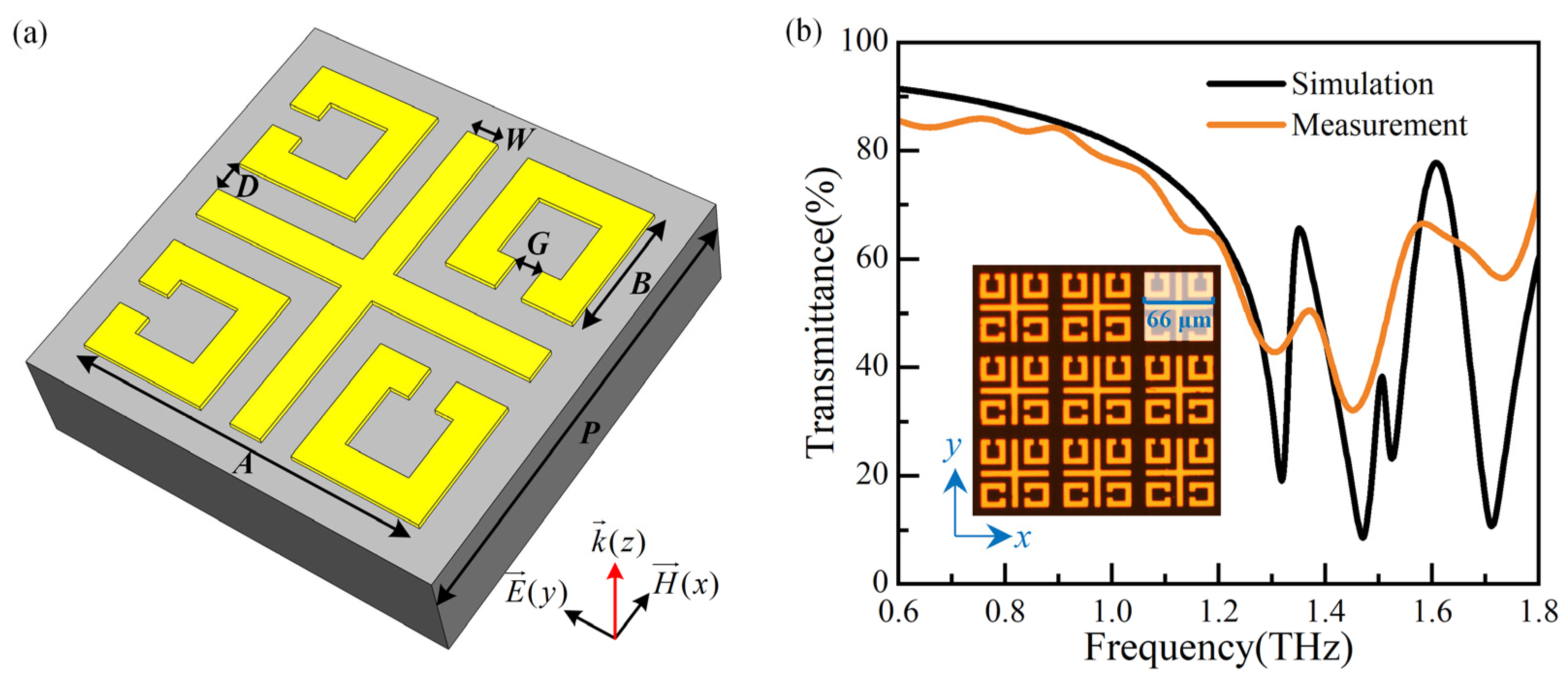

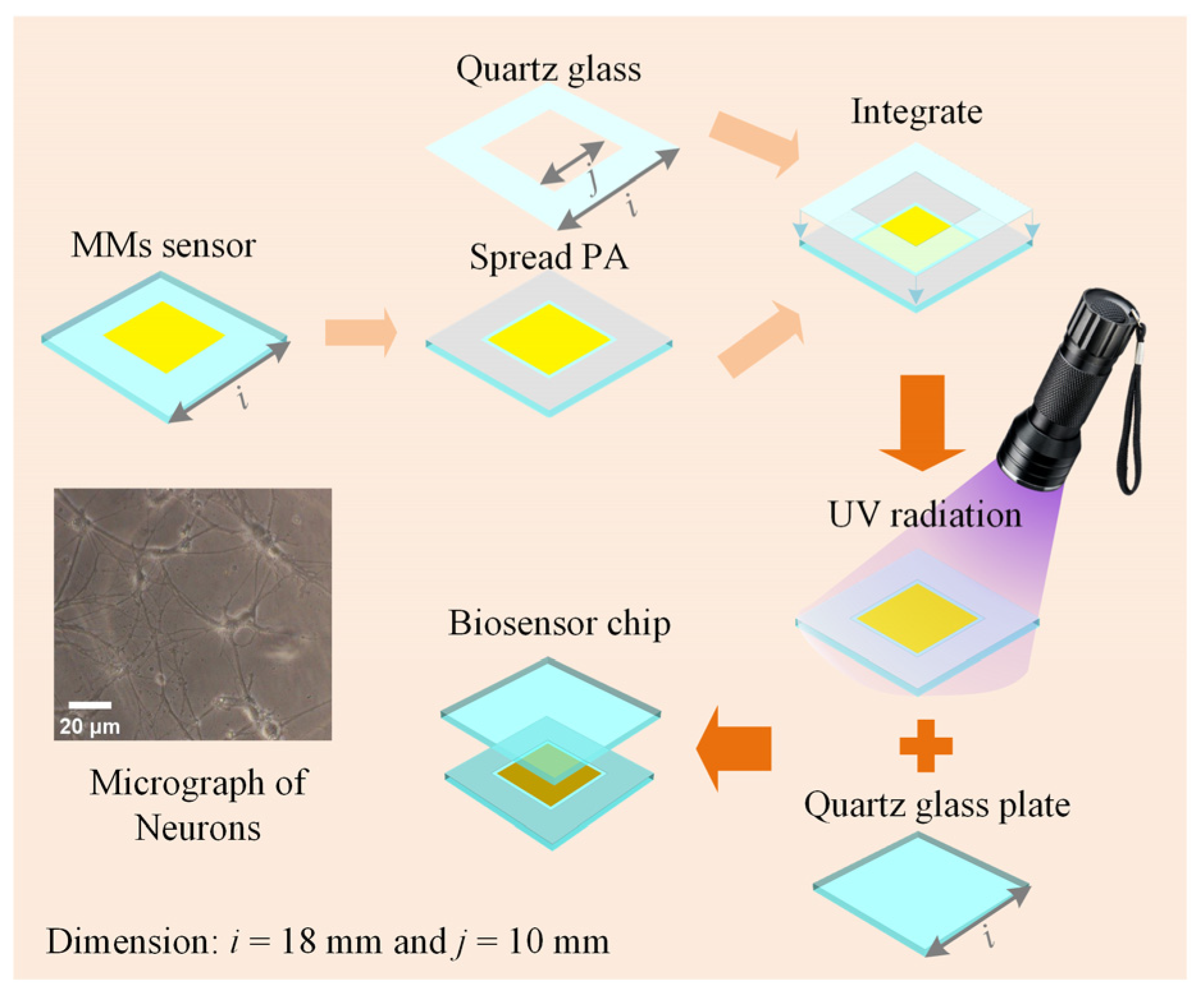
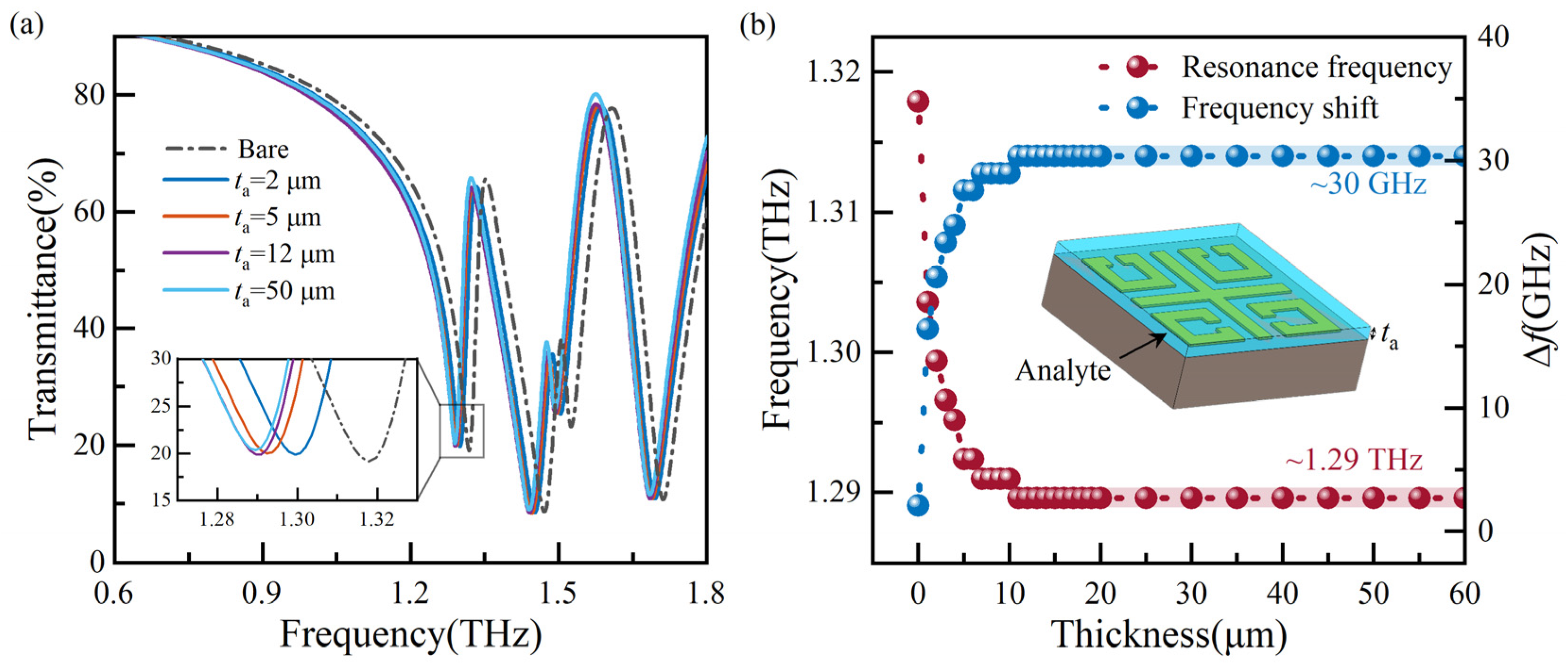
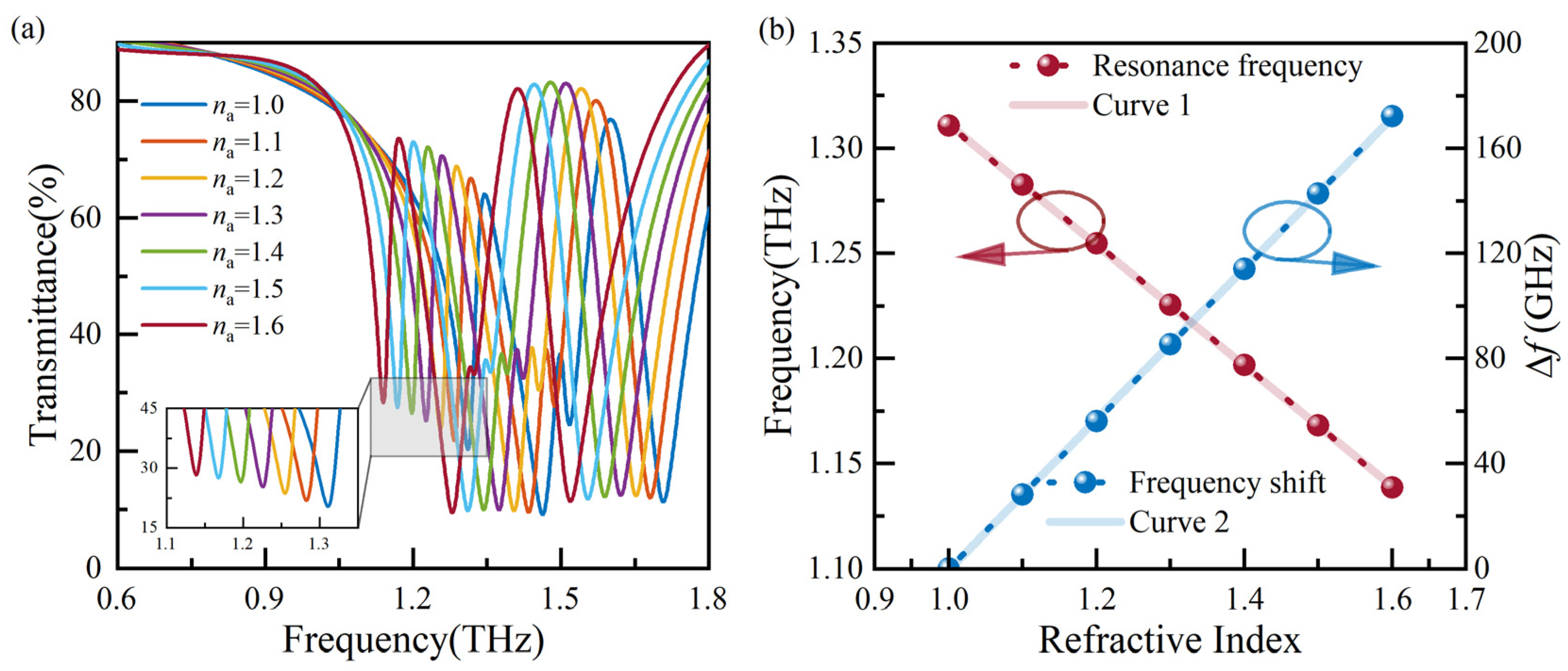
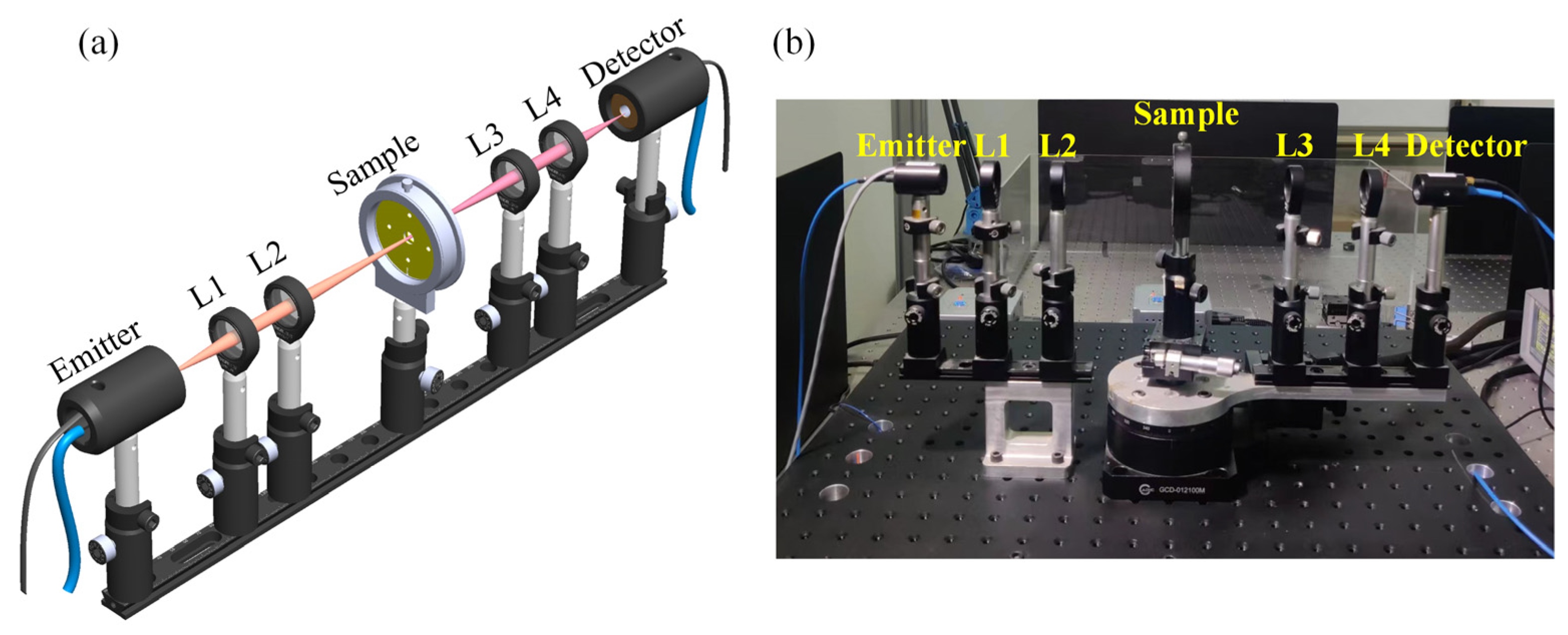
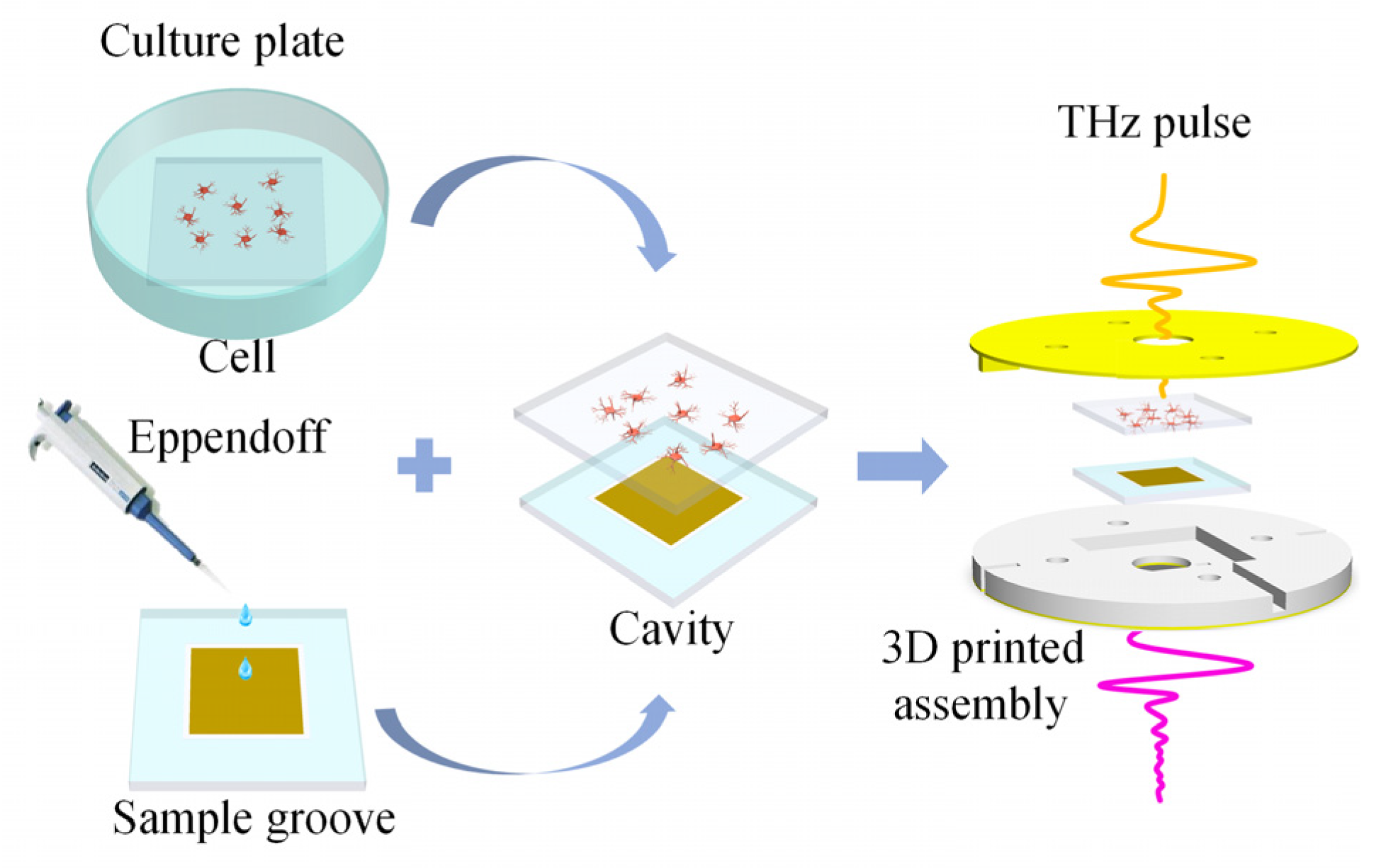

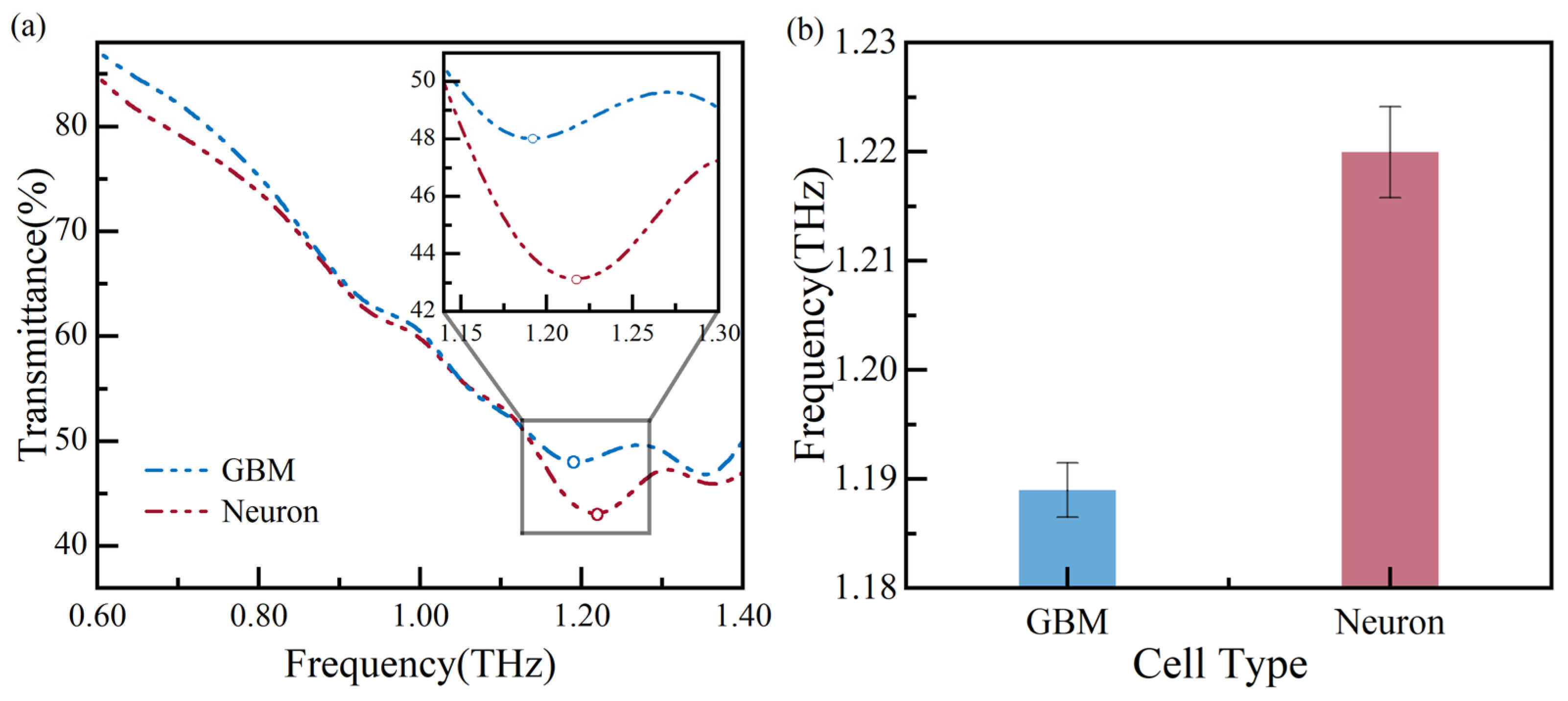
| Chemical Reagent | Source | Identifier |
|---|---|---|
| DEME High Glucose | Biosharp | Cat. No: BL304A |
| FBS | Gibco | Cat. No: 10099141C |
| Trypsin | Biosharp | Cat. No: BL512A |
| PBS | Sigma | Cat. No: D8537 |
| Neurobasal-A medium | Gibco | Cat. No: 10888-022 |
| PDL | Sigma | Cat. No: P4707 |
| Temozolomide | Sigma | Cat. No: T2577 |
| Cell Counting Kit-8 | MedChemExpress | Cat. No: HY-K0301 |
| TMZ Action Time (h) | Cell Viability (%) | Cell Concentration (Cells/cm2) |
|---|---|---|
| 0 | ~95.0 | ~4938 |
| 24 | ~86.9 | ~4516 |
| 48 | ~84.4 | ~4386 |
| 72 | ~79.2 | ~4116 |
| Ref. | f0 | S | Sf0 | Ccell | Analyte |
|---|---|---|---|---|---|
| [9] | 0.850 THz | 0.074 THz/RIU | 8.7% | - | Vitro tissues |
| [11] | 0.850 THz | 0.182 THz/RIU | 21.4% | 2 × 106 cells/mL | Dried adherent cells |
| [14] | 0.777 THz | 0.118 THz/RIU | 15.2% | 1 × 105 cells/cm2 | Adherent cells |
| [29] | 1.180 THz | 0.249 THz/RIU | 21.1% | 0.5 × 105 cells/mL | Adherent cells |
| This work | 1.320 THz | 0.287 THz/RIU | 21.7% | 5200 cells/cm2 | In vivo-like cells |
Disclaimer/Publisher’s Note: The statements, opinions and data contained in all publications are solely those of the individual author(s) and contributor(s) and not of MDPI and/or the editor(s). MDPI and/or the editor(s) disclaim responsibility for any injury to people or property resulting from any ideas, methods, instructions or products referred to in the content. |
© 2024 by the authors. Licensee MDPI, Basel, Switzerland. This article is an open access article distributed under the terms and conditions of the Creative Commons Attribution (CC BY) license (https://creativecommons.org/licenses/by/4.0/).
Share and Cite
Han, L.; Wang, Y.; Chen, K.; Gao, H.; Xia, K.; Ge, Q.; Yang, J.; Shi, W.; Ruan, C. Detection of In Vivo-like Cells by a Biosensor Chip Based on Metamaterials in Terahertz Regime. Biosensors 2024, 14, 230. https://doi.org/10.3390/bios14050230
Han L, Wang Y, Chen K, Gao H, Xia K, Ge Q, Yang J, Shi W, Ruan C. Detection of In Vivo-like Cells by a Biosensor Chip Based on Metamaterials in Terahertz Regime. Biosensors. 2024; 14(5):230. https://doi.org/10.3390/bios14050230
Chicago/Turabian StyleHan, Lulu, Yuchen Wang, Kanglong Chen, Hengyu Gao, Kexin Xia, Qinggang Ge, Jun Yang, Wei Shi, and Cunjun Ruan. 2024. "Detection of In Vivo-like Cells by a Biosensor Chip Based on Metamaterials in Terahertz Regime" Biosensors 14, no. 5: 230. https://doi.org/10.3390/bios14050230
APA StyleHan, L., Wang, Y., Chen, K., Gao, H., Xia, K., Ge, Q., Yang, J., Shi, W., & Ruan, C. (2024). Detection of In Vivo-like Cells by a Biosensor Chip Based on Metamaterials in Terahertz Regime. Biosensors, 14(5), 230. https://doi.org/10.3390/bios14050230






